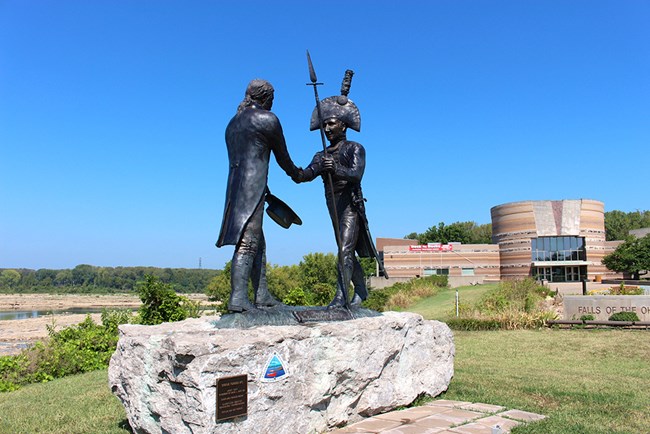Last updated: August 31, 2020
Article
Lewis and Clark in Clarksville, Indiana

Photo: The statue outside the Falls of the Ohio Interpretive Center which commemorates the meeting of the two Captains. The importance of this event was best summarized by historian and author Stephen E. Ambrose who wrote, “When they shook hands, the Le
The history of Clarksville goes back to 1778, when George Rogers Clark, William’s older brother, established a post on an island at the Falls of the Ohio during the American Revolution. At this post, Clark trained a regiment of 175 men for defense of the area. After the war, George Rogers Clark was given approximately 150,000 acres as a thanks for his service in the war. Clark set aside 1,000 acres of his tract for the development of a community. During this same time, a stockade was constructed, and settlement of the area was underway.
Lewis and Clark remained in the area for about two weeks, recruiting and enlisting members of the Corps, purchasing additional supplies, and preparing for the journey west.
The area where Lewis and Clark took off from is now Falls of the Ohio State Park, located on a Devonian fossil bed and part of a National Wildlife Conservation Area. The Devonian period occurred from 416 million to 358 million years ago, and when the Ohio River is not at flood stage, there is a large exposed fossil bed on the Jeffersonville Limestone bedrock, which you can actually walk upon to see the prehistoric fossils.
Within the park is the Falls of the Ohio Interpretive Center where you’ll enjoy exhibits that explain the area’s history, focusing on how this river crossroads shaped the America we know today, including the story of Lewis and Clark. Just a short hike downstream, you’ll find the Clarksville Bicentennial Park which has several information signs, a replica keelboat, and an early 19th century cabin similar to that of George Rogers Clark, where William lived prior to the Expedition. For more information, go to www.fallsoftheohio.org.
